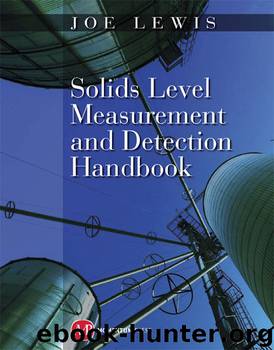Solids Level Measurement and Detection Handbook by Lewis Joe

Author:Lewis, Joe.
Language: eng
Format: epub
Publisher: Momentum Press
Published: 2011-12-09T16:00:00+00:00
Acoustic
Acoustics is the study of mechanical waves in gases, liquids, and solids, and includes sound and ultrasound. The difference between sound and ultrasound is simply the frequency of the mechanical wave. Ultrasound deals with frequencies above human hearing, typically frequencies of 20 kHz and above. In level sensor technology, sound and ultrasound fall into the same category that we identify here as acoustic. But frequency does matter, as we will discuss, so it is important to note that the acoustic sensor frequency of operation plays an important part in the application of this technology to the level measurement of a bulk solid material.
Acoustic level sensor technology is a mature technology and, although they have not been around anywhere near as long as the weight and cable level sensors, acoustic devices have been in industrial use for measuring material levels (traditionally just liquids) since the 1970s. However, even as far back as the early 1920s scientists and inventors were thinking of ways sound energy could be transmitted into a medium for the purposes of measuring flow or distance.
Acoustic level sensors are solid-state devices without mechanical moving parts other than the components used to generate the mechanical sound waves, typically piezoelectric devices. Acoustic sensors are one of several technologies using the measurement principle of time-of-flight. That is, the distance from the sensor to the material surface is directly related and calculated based upon the time it takes the acoustic energy to travel to the surface of the material, reflect, and return to the sensor transducer. This time is based upon the distance and the speed of sound through the empty space medium (usually air within vented bins and silos) in a static condition.
The operating frequency of the acoustic level sensor can vary from as low as 3 kHz to as high as 80 kHz. Figure 6-3 is a typical acoustic level sensor transducer used for powder and bulk solids level measurement. Sound energy is transmitted through the internal empty space of a bin as a longitudinal wave with a frequency, and a wavelength unique to the frequency. The frequency is how often the sound wave repeats during a defined time period such as one second. The wavelength is the distance over which each sinusoidal longitudinal wave will repeat. The higher the frequency, the shorter is the wavelength. The shorter the wavelength, the more problematic is propagation through airborne solid particles like dust because of attenuation, thus shortening (significantly in many cases) the measuring range and eliminating measurement during filling of dusty bulk solids.
Download
This site does not store any files on its server. We only index and link to content provided by other sites. Please contact the content providers to delete copyright contents if any and email us, we'll remove relevant links or contents immediately.
| Automotive | Engineering |
| Transportation |
Whiskies Galore by Ian Buxton(41937)
Introduction to Aircraft Design (Cambridge Aerospace Series) by John P. Fielding(33091)
Small Unmanned Fixed-wing Aircraft Design by Andrew J. Keane Andras Sobester James P. Scanlan & András Sóbester & James P. Scanlan(32763)
Craft Beer for the Homebrewer by Michael Agnew(18194)
Turbulence by E. J. Noyes(7977)
The Complete Stick Figure Physics Tutorials by Allen Sarah(7336)
Kaplan MCAT General Chemistry Review by Kaplan(6899)
The Thirst by Nesbo Jo(6877)
Bad Blood by John Carreyrou(6581)
Modelling of Convective Heat and Mass Transfer in Rotating Flows by Igor V. Shevchuk(6406)
Learning SQL by Alan Beaulieu(6237)
Weapons of Math Destruction by Cathy O'Neil(6213)
Man-made Catastrophes and Risk Information Concealment by Dmitry Chernov & Didier Sornette(5951)
Digital Minimalism by Cal Newport;(5700)
Life 3.0: Being Human in the Age of Artificial Intelligence by Tegmark Max(5509)
iGen by Jean M. Twenge(5384)
Secrets of Antigravity Propulsion: Tesla, UFOs, and Classified Aerospace Technology by Ph.D. Paul A. Laviolette(5332)
Design of Trajectory Optimization Approach for Space Maneuver Vehicle Skip Entry Problems by Runqi Chai & Al Savvaris & Antonios Tsourdos & Senchun Chai(5037)
Pale Blue Dot by Carl Sagan(4952)
